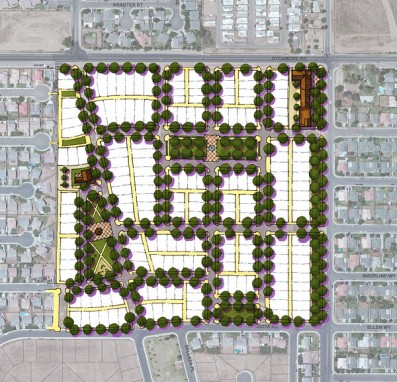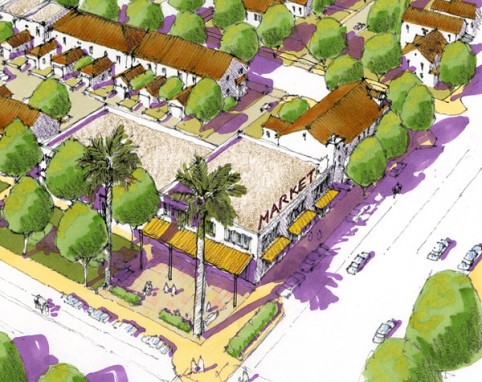The project included some interesting ideas for bringing central amenities and services to disadvantaged neighborhoods, and is characteristic of the kinds of interdisciplinary partnerships necessary to make good things happen these days.
Some background: The plan included community design charrettes for one town, Arvin, and two unincorporated communities, Lamont and Weedpatch. All three communities have a mainly agricultural economy, with a high percentage of Hispanic farmworkers. There is widespread poverty, with many who walk, bike, and take public transportation, however there is very little basic infrastructure to support these activities, such as sidewalks, bicycle lanes, and safe pedestrian crossings. The climate is hot and arid, but there is little shade or shelter for pedestrians. In this remote part of Kern County, residents have limited access to basic services, including medical care and healthy food. All three communities are “food deserts,” with few full-service grocery stores.
South Kern County, like the rest of the San Joaquin Valley, was hit hard during the Great Recession, and local planning departments and county agencies are stretched thin, making it very difficult to plan for and invest in infrastructure. At the same time, resources have never really been great, and there is a long history of community organizing and advocacy, with many groups ready to confront problems with hard work, innovation, and creativity. These values and traditions date back to the Dust Bowl, when the area first welcomed fleeing “Okies” in the 1930s, and the 1960s, when Cesar Chavez and Dolores Huerta became active locally with farmworkers’ rights.
Rather than a traditional client-consultant relationship, the project was made possible through a four-way partnership between Kern County, the City of Arvin, our long-standing collaborators at the Local Government Commission, and the South Kern Building Healthy Communities Group. The BHC, a project of the California Endowment’s Building Healthy Communities Initiative, is working in South Kern and 13 other California communities to encourage healthy, safe, and clean places. They engaged with several fantastic groups working in the area, such as the Center for Race, Poverty and the Environment and California Rural Legal Assistance, and hired our team, which included our colleagues at Nelson\Nygaard.
In all, we had a great experience developing the plan with the three communities. While our work in Lamont and Weedpatch focused mainly on design improvements that would create a safer and more comfortable environment for pedestrians and bicyclists in the vicinity of Highway 184, in Arvin we focused on planning and urban design for several infill sites in the city. The project partners were very interested in understanding how these could emerge as walkable, mixed-use environments that would provide new opportunities for housing convenient to jobs, services, institutions, and open space, all in an environment conducive to healthy living.

One of these sites included 40 acres of city-owned, vacant land in southern Arvin, which had seen a lot of growth in the run-up to the downturn. The surrounding neighborhoods, however, were built with no services and very little pedestrian connectivity. Residents without cars have few choices to obtain daily needs and services within walking distance.
During the Arvin charrette, discussions with the community confirmed this strong need for services, and cited a desire for access to healthy foods, basic health care, and safe and welcoming public space. A network of streets and blocks would connect to downtown Arvin and provide a framework for Missing Middle housing types to anchor the neighborhood.
But how to implement such a neighborhood center? The vision is just the first step; the city will play a role through land use policies and zoning regulations that incentivize and enable pedestrian-friendly, mixed-use development, and can ultimately pursue infrastructure projects, such as sidewalks and civic spaces that can help to make private development more attractive. However, encouraging the free market to provide such a development will still be difficult, if not impossible. The daily traffic traveling along the site’s two collector streets will hardly justify private investment interest, and the neighborhood’s existing spending power will likely discourage conventional “formula” retailers.

Enter the California Endowment’s California Freshworks Fund, which has raised $272 million to seed healthy food retailers in underserved communities, and has expressed interest in helping to bring a corner grocer to the location. Two other groups working to improve public health in the Valley have recommended the establishment of “health enterprise zones” that would provide tax credits and other financial incentives for health care providers, such as a young doctor or dentist, to locate next door. While the HEZ is a relatively new idea in California, it’s one that has been successfully implemented elsewhere and is starting to gain traction. Orienting these two elements onto a well-scaled, well-designed civic space (that can both manage local stormwater and provide a setting for local vendors and food trucks), we believe can create enough critical mass to serve as a positive catalyst for the neighborhood.
In the coming months, the project’s implementation working group will be actively working to fund public improvements, search for potential tenants and operators, and make the project a reality.